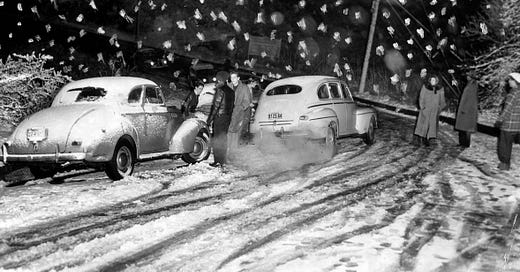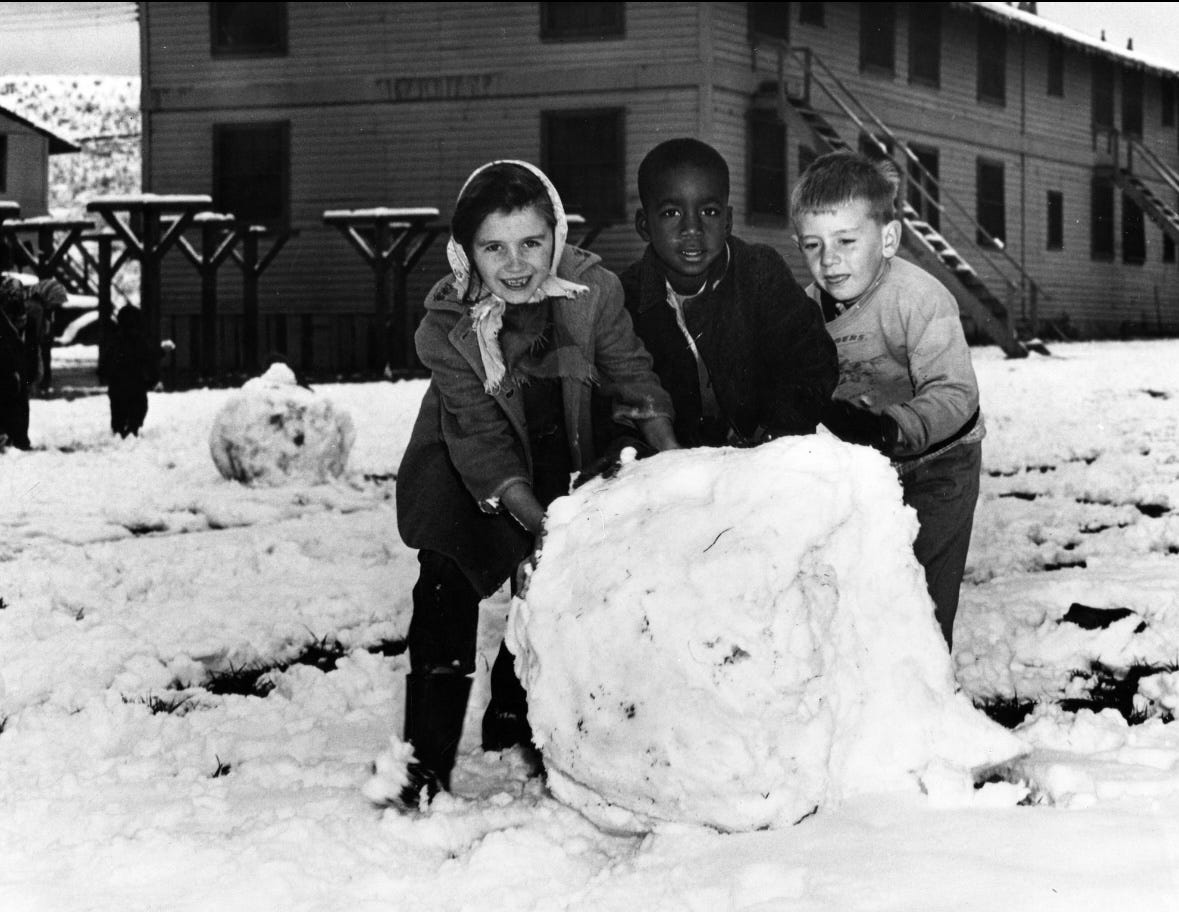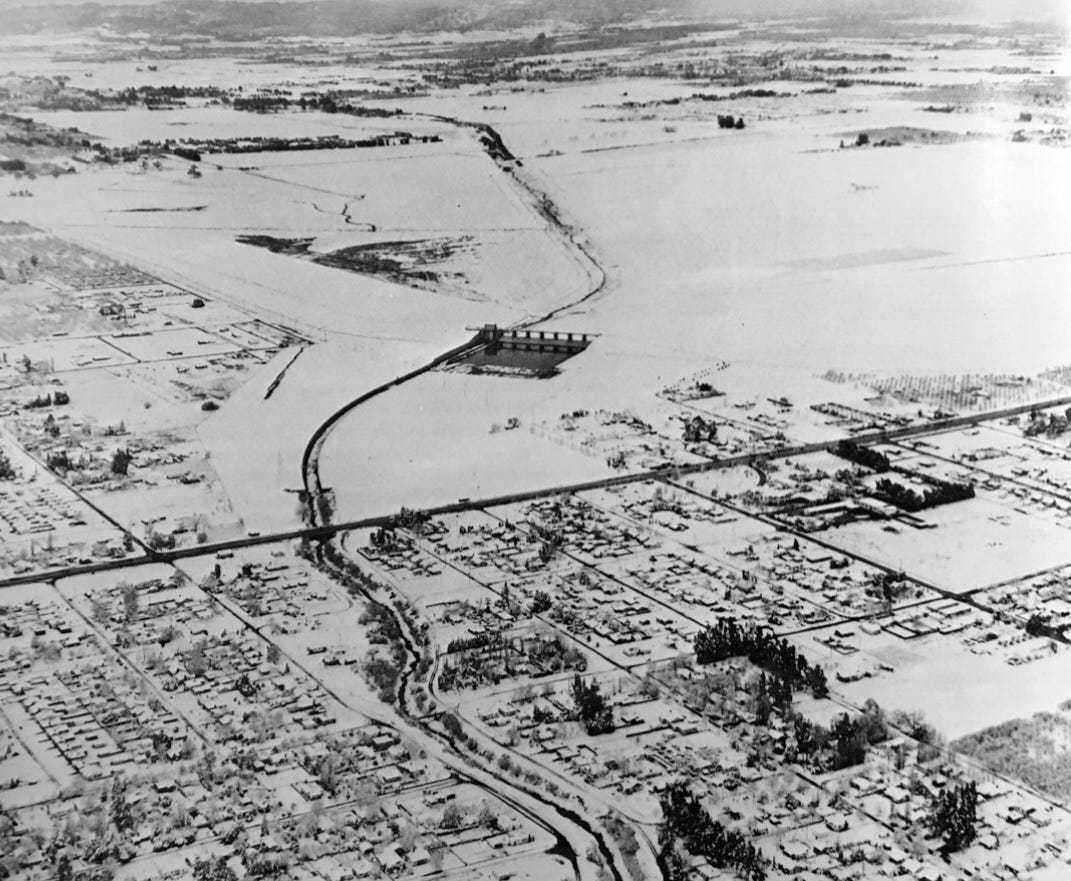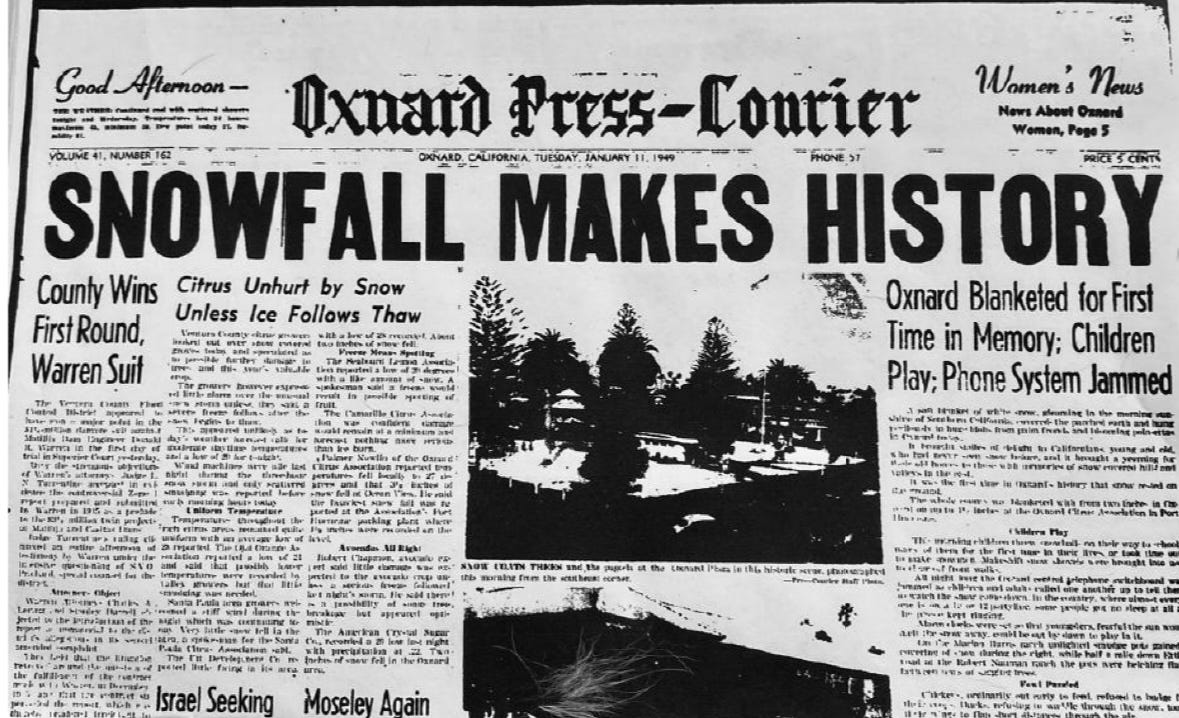L.A.'s Last Big Snowfall (Yes, it snowed in L.A.) & Why It May Never Happen Again
Seventy-six years ago today, a huge snowstorm hit Los Angeles and all of Southern California. It's barely snowed since and not at all since 1962
The snow began falling the afternoon of January 9, 1949. It was a Sunday and it was brutally cold by Southern California standards, just a tick over the freezing mark downtown Los Angeles.
In the San Fernando Valley, which was then still semi-rural, the temperature was in the 20s. Then, as now, a lot of people who lived in the Los Angeles area were transplants from states where it snowed in winter, so they would have recognized what was happening even if it was startling to see in Southern California. But many others had never seen anything like this where they lived. Some had never seen snow anywhere. They must have looked up in bafflement as flakes came twirling down among the palm trees.
The conditions for the snowstorm had come roaring down from Alaska in the form of a mass of extraordinarily cold air that met a low pressure system over the western continental U.S.. By January 10, the snow was general all over Southern California, from Bakersfield to the Mexican border, from the Pacific Ocean to the Nevada and Arizona state lines.
Cars stuck in Coldwater Canyon. Photo credit: Los Angeles Public Library
Overnight, the snow became heavier. Downtown, the first flakes had melted as soon as they reached the ground. In the roads through the Hollywood Hills - Laurel Canyon, Coldwater Canyon, Benedict Canyon - and in the Valley, it began snowing hard. Cars began to get stuck trying to make it through the canyon passes.
"A score of cars (were) trapped in a foot of snow in Laurel Canyon, with several children among the occupants," reported the L.A. Times
At the Basilone housing project in the Valley, recently built for World War Two veterans and their families, kids went nuts, frolicking in the snow and built snowmen. School was cancelled. On the campus of UCLA, a woman skied down an incline as her friends cheered her on.
Children at the Basilone housing project in the Valley
At one intersection near downtown, three children hurled snowballs at passing cars until one broke a window and slightly injured a passenger.
Los Angeles Times columnist Cecilia Rasmussen wrote in 1999, on the occasion of the 50th anniversary of the '49 snowfall, "The Rose Bowl was transformed into a 'dishpan full of milk,' by one account. An Alhambra hardware store put out a sign that said, 'Snow Plows for Rent - Hurry!' A snowman appeared in Eagle Rock, wearing a sombrero, and the city of Reno, Nev., sent L.A. a snow shovel."
There was snow on the beaches. There was snow even in Palm Springs and on Catalina Island, 24 miles off the coast. Hardest hit were the San Gabriel and San Bernardino mountains, but that wasn't unusual. Southern California mountains regularly got snow and still do.
In the Valley and further east, where citrus was a major business, farmers began burning smudge pots to save the oranges and lemons from the cold. The snowstorm would cause an estimated $45 million in damage (around $600 million in 2025 dollars).
A helicopter pilot flying from the airport to the downtown main post office said "it was like flying inside a snowball."
The storm paralyzed the city. People stayed home from work, huddled inside and turned up the heat. Traffic signals stopped working because of the prolonged cold snap. The local gas utility registered record demand.
San Fernando Valley. Photo credit: Los Angeles Dept. of Water and Power
The snow continued in the L.A. area and elsewhere through the night of the 10th. The roads through the Hollywood Hills were finally closed to all traffic. Mulholland Drive, running along the ridge and treacherous even in fine weather, was shut down.
The next day, the L.A. Times headline screamed:
SNOW REDOUBLES ATTACK ON L.A.; HALTS TRAFFIC THROUGH CANYONS.
The article said, "The Times' switchboard received numerous calls from residents in all parts of the city reporting what they described as winter scenes 'just like back east.'"
The Oxnard Press-Courier almost poetically described the landscape there. "A soft blanket of white, gleaming in the morning sunshine of Southern California, covered the parched earth and hung in huge blobs from palm fronds and blooming poinsettias in Oxnard today."
Years later, Linda Plummer, who was a child living in Camarillo that winter, would remember it.
"I recall being excited when I first saw it and said to my Dad, 'Come, look at the snow!' Being from Minnesota, he continued reading his paper and said, 'I've seen snow.'"
Leonard Cruz, also from Camarillo, which is about 60 miles west of downtown Los Angeles, had never seen snow before. He was bedazzled.
"It was as white as could be," he said. "Lots of snow. Snow was on the horses in the pastures."
Photo credit: Los Angeles Dept. of Water and Power
At the time, the 1949 snowfall was extraordinary because it was so heavy and so widespread. But it was not unprecedented. In the 20th century, it snowed in parts of Los Angeles in 1913, 1921, 1922, 1926 and 1944. There was a snowstorm in 1882 that was even heavier than the one in 1949, prompting a Los Angeles Herald headline, "How's That for Semi-Tropical?"
In a 2016 article posted on pbssocal.org, Why Doesn't It Snow in L.A. Anymore, Nathan Masters wrote, "For generations, Angelenos could count on waking up, at least once or twice in their lives, to a wintry scene: children pelting each other with snowballs beneath powder-dusted palm trees."
Trace amounts of snow would fall again in 1957 and 1962. That was the last time.
Bill Pazeet, a climatologist at the NASA Jet Propulsion Lab in Pasadena, blames the snow drought on the urban heat island effect - paved surfaces are hotter than the natural ground - and climate change. Winter temperatures, particularly average daily lows, have risen dramatically over the past 75 years. While he said it's not impossible for it to snow again in Los Angeles, "by 2050, no way."
The 1949 snowfall lasted four days. Downtown got about 2 inches of slushy snow. Elsewhere, up to a foot fell. It stopped snowing on January 13. Temperatures rose. Soon the snow was gone, leaving only the memory. Today, there are few people alive to remember it.
On this 76th anniversary of the last big snowfall in Los Angeles, the city is currently experiencing near drought conditions. Downtown L.A. has recorded just 0.29 inches of rain since last May, contributing to the extremely dry conditions that are helping fuel the horrific wildfires this week in the Los Angeles area. There's no rain - or snow - in the forecast for at least the next 10 days.









Love the pics, too!
This seems even more timely since places like New Orleans have just gotten battered!